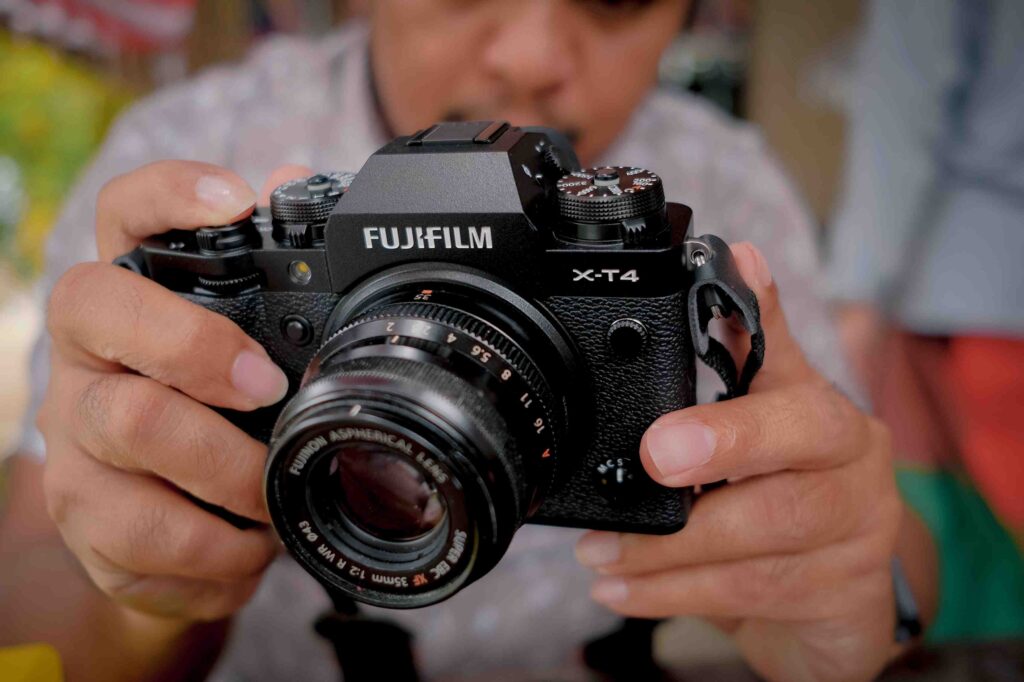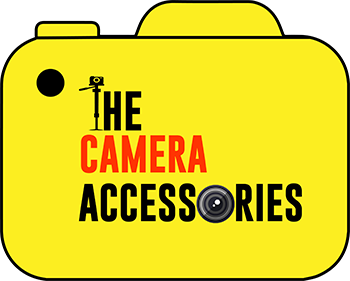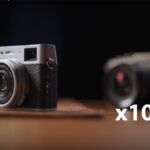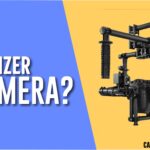The best APS-C mirrorless camera accessible at present is the Fujifilm X-T4. The far greater life of the battery, in-body image stabilization, quieter shutter, and design changes that improve handling are all compelling photographers and filmmakers to pick the X-T3 over it. The X-T4 has a lovely and easy-to-use look, and the class-leading video and photo specs are supported by excellent performance. This is a fantastic hybrid all-rounder that has many cameras in one.

Pros
- Rock-solid design
- class-leading APS-C sensor
- IBIS is a huge plus for video and still photos
- long-lasting battery and logical menu structure
Cons
- The choice of lens limits the possibilities for AF performance.
- EVF behavior in
- low-contrast light
- Headphone Jack is gone
The Fujifilm X-T4 is a mirrorless camera with two distinct personalities. On the outside, it’s all traditional dials and analog style, but on the inside. it’s packed with more innovative features than every other Fujifilm X-T camera yet.
This combination is intriguing. The Fujifilm X-T4 is for dedicated photographers of all levels who want the most recent mirrorless power in a fun, attractive package. like the X-T3 (which remains accessible). This time, the X-T4 is cranking up the ‘all-rounder’ dial to 11.
This is the second-ever Fujifilm camera with in-body image stabilization (IBIS), the other being the Fujifilm X-H1. This is the most significant development. IBIS can be helpful for both still and video photographers in particular, and by adding it here, the X-T4 gets up to date with rivals like the Sony A6600.
A bigger battery (check), improved autofocus (check), and, of course, a new film simulation effect (dubbed Bleach Bypass). fill up the rest of the X-T4’s new features.
But, the same camera and processing mix as its predecessor is paired with these interesting innovations. In light of this, may we suggest that you just stick with the Fujifilm X-T3? What about the video-focused X-H1?
Our review focuses a little more on the X-T4’s improvements and the impact of those characteristics, so as to make it more apparent. For the majority of other things, our Fujifilm X-T3 review is still valid.
We’ll just say that the Fujifilm X-T4 is an excellent camera with plenty of power under the hood and tremendous personality traits. It merits every single spot in our compilation of the top cameras for capturing images, as well as in the lists of the best cameras for filming movies and even the best camera for YouTube. We have a true photography-video combination from Fujifilm more than ever before.
Date and cost of the Fujifilm X-T4 release
The Fujifilm X-T4 is now offered for buy in an array of bundles.
The initial cost is $1,699, £1,549, or AU$2,999.
The Fujifilm X-T4 has been made available for sale in an array of bundles. A body-only X-T4 costs $1,699, £1,549, / AU$2,999, and comes in black or silver.
The price of a set that comprises the excellent XF18-55mm f/2.8-4 R LM OIS kit lens is $2,099, £1,899, or AU$ 3,298. Or, if you’d rather, you may pay $2,199 (£1,949; AU$ 4,099) for the X-T4 with the new XF16-80mm f/4 R OIS WR lens.
It’s essential to note that the Fujifilm X-T3 will be accessible for sale if the associated expenses are somewhat high for you. It now costs $1,299 / £1,199 to buy this camera.
It’s essential to note that the Fujifilm X-T3 is going to be accessible for sale if the associated expenses are a little too much for you. If you don’t need IBIS or any of the other new capabilities of the X-T4, the camera is now less expensive at $1,299, £1,199, or AU$1,823.
, the cost of the Fujifilm X-T4 puts it on a level with numerous full-frame cameras, including the Nikon Z6 and Sony A7 III. Yet, while possessing a smaller sensor than those cameras, it does have some additional benefits we’ll discover.
Form and handling Of fujifilm xt4

Relative to the Fujifilm X-T3, the X-T4 is just slightly bigger and heavier.
The construction is of the highest caliber, yet a larger handgrip would be welcome.
Its magnesium alloy construction remains weatherproof.
Fujifilm doesn’t often deviate substantially from its traditional layout, and the X-T4 is not an exception. Simply put, if you’ve ever used an X-T series camera, you’ll be at home with this one.
We like the high-end Fujifilm X-T concept. The large analog-style dials on the top plate are its focal point. The ISO, shutter speed and exposure compensation controls are on distinct dials.
These dials are not only slower than utilizing current generic control dials, but they are also certainly more careful and endearing.
The X-T4 is your go-to camera if a camera’s design inspires you to use it more. Fans of the camera certainly feel an intense connection to them.
For connecting the headphones, a USB-C to 3.5mm converter is included in the box, but you can’t charge the camera at the same time.
The strengthened handgrip is still sufficient for us. Why not offer a grip that is even deeper and nicer to use, considering that the X-T4 is already a DSLR-style camera? After that, it depends on which of your lenses.
Metering is no longer operated through the switch below the shutter speed dial, which instead toggles between Still and film modes. Some passionate shooters will be offended at the elimination of the metering switch, but it makes sense whether you shoot pictures or videos with the camera.
New dedicated menu systems are now available for both still and motion picture photography as a result of this modification. The in-camera menu system and the Q menu, for instance, only offer picture options while the camera is in Still mode. The menus change to video options when you select a video, and the analog levers cease functioning.
The front and back clicked knobs that are used for adjusting exposure when storing video. Both during capture and when utilizing the touchscreen, these alterations are available.
We adore the rational separation of the two disciplines in addition to the simple menus. A seemingly minor design change really emphasizes the X-T4’s status as a true hybrid camera.
We have now reached the LCD touchscreen. The 3-inch display’s resolution has been increased to 1.62 million dots, and the unit is now fully articulated rather than tilted.
The LCD screen may be rotated and viewed in “selfie” mode by flipping it out to the side. A front-facing screen is especially helpful for independent filmmakers. The screen has a gorgeous faux-leather surface that can be safely folded away. We have really loved going screen-free and concentrating on the EVF.
Some claim that when flipped out, an articulated screen design is more brittle than the tilt-type. The ports on the side of the camera may become obstructed by it (Fujifilm has changed the port covering in the X-T4 as In addition, you are viewing it off-cantered and it may not be appropriate with an L-Bracket support (it has two pull-out rubber doors).
We aren’t certain which screen style we prefer for the X-T series’ flagship models, but it isn’t a deal-breaker either way. Because it’s a little more difficult than a flip screen when shooting from the hip, the X-T4 screen slightly favors video.
Like its predecessors before it, the X-T4 records to an SD card, and both slots accept the ultra-fast UHS-II kind of card that is needed for high-speed continuous shooting and high-resolution movies.
Autofocus and features of Fujifilm X-T4

There is a total of five types of in-body image stabilization on the Fujifilm X-T4.
With some lenses, this provides stabilization up to 6.5 stops.
It is capable of recording at up to 15 fps thanks to a modified, quieter shutter technology.
The Fujifilm X-T4 is the biggest step forward for the series yet, thanks to three key new features: IBIS, a new battery, and a new shutter mechanism. It may look remarkably comparable to its X-T predecessors.
The X-T4’s primary features are otherwise nearly identical to those of the X-T3, a camera that is 18 months older. The 26.1MP backlit APS-C sensor, which is best in class for detail and low light performance, is incorporated. Don’t shoot an object that isn’t cracked.
A further film shooting standard that is nevertheless in effect today is for Cinema 4K movies with frame rates of as much as sixty frames per second, 10-bit internal recording and HDMI out, a bit rate of up to 400 Mbps, and standard integration of the F-Log and HLG profiles. Up to 240 images per second, slow motion Full HD movies are also possible. The X-T4 can create stunning videos if that is what you desire.
The in-body image stabilization (IBIS) is the real big news, though. When paired with one of Fujifilm’s stabilized lenses, the sensor-shift unit surpasses the one in the X-H1 by one stop and provides stabilization of up to 6.5EV (or exposure value). This includes 18 of the 29 lenses provided by Fujifilm, which is particularly interesting if you currently own antique prime lenses like the XF35mm f/1.4 or XF56mm f/1.2.
Run-and-gun filmmakers who want steady handheld shots without relying on a gimbal are especially interested in image stabilization. In the “Performance” section below, we’ll discuss our experience with it.
A few upgrades have been made to the shutter, making it more durable with a 300,000-shot life, 30% quieter than the X-T3 model, and faster with a new top speed of 15 frames per second.
Naturally, if the autofocus can keep up with the activity, this speed could be more useful. Fortunately, Fujifilm has improved its AF system for the X-T4 as well. Fuji asserts that the X-T4’s tracking success rate is twice as good as the X-T3, which wasn’t exactly lacking in this area, and the Face / Eye AF has also been improved.
Full specifications of Fujifilm X-T4
| MSRP | $1699 (body only), $2099 (w/18-55mm lens), $2199 (w/16-80mm lens) |
| Body type | |
| Body type | SLR-style mirrorless |
| Body material | Magnesium alloy |
| Sensor | |
| Max resolution | 6240 x 4160 |
| Image ratio w:h | 1:1, 3:2, 16:9 |
| Effective pixels | 26 megapixels |
| Sensor size | APS-C (23.5 x 15.6 mm) |
| Sensor type | BSI-CMOS |
| Processor | X-Processor 4 |
| Color space | sRGB, Adobe RGB |
| Color filter array | X-Trans |
| Image | |
| ISO | Auto, 160-12800 (expands to 80-51200) |
| Boosted ISO (minimum) | 80 |
| Boosted ISO (maximum) | 51200 |
| White balance presets | 7 |
| Custom white balance | Yes (3 slots) |
| Image stabilization | Sensor-shift |
| Image stabilization notes | Some lenses limited to 5 stops of correction |
| CIPA image stabilization rating | 6.5 stop(s) |
| Uncompressed format | RAW |
| JPEG quality levels | Fine, normal |
| File format | JPEG (Exif v2.3)Raw (14-bit RAF) |
| Optics & Focus | |
| Autofocus | Contrast Detect (sensor)Phase DetectMulti-areaCenterSelective single-pointTrackingSingleContinuousTouchFace DetectionLive View |
| Autofocus assist lamp | Yes |
| Manual focus | Yes |
| Number of focus points | 425 |
| Lens mount | Fujifilm X |
| Focal length multiplier | 1.5× |
| Screen / viewfinder | |
| Articulated LCD | Fully articulated |
| Screen size | 3″ |
| Screen dots | 1,620,000 |
| Touch screen | Yes |
| Screen type | TFT LCD |
| Live view | Yes |
| Viewfinder type | Electronic |
| Viewfinder coverage | 100% |
| Viewfinder magnification | 1.125× (0.75× 35mm equiv.) |
| Viewfinder resolution | 3,690,000 |
| Photography features | |
| Minimum shutter speed | 30 sec |
| Maximum shutter speed | 1/8000 sec |
| Maximum shutter speed (electronic) | 1/32000 sec |
| Exposure modes | ProgramShutter priorityAperture priorityManual |
| Built-in flash | No |
| External flash | Yes (via hot shoe or flash sync port) |
| Flash X sync speed | 1/250 sec |
| Drive modes | SingleContinuous (L/H)Bracketing |
| Continuous drive | 20.0 fps |
| Self-timer | Yes |
| Metering modes | MultiCenter-weightedAverageSpot |
| Exposure compensation | ±5 (at 1/3 EV steps) |
| AE Bracketing | ±5 (2, 3, 5, 7 frames at 1/3 EV, 2/3 EV, 1 EV, 2 EV steps) |
| WB Bracketing | Yes |
| Videography features | |
| Format | MPEG-4, H.264, H.265 |
| Modes | 4096 x 2160 @ 60p / 200 Mbps, MOV, H.265, Linear PCM4096 x 2160 @ 50p / 200 Mbps, MOV, H.265, Linear PCM4096 x 2160 @ 30p / 400 Mbps, MOV, H.265, Linear PCM4096 x 2160 @ 25p / 400 Mbps, MOV, H.265, Linear PCM4096 x 2160 @ 24p / 400 Mbps, MOV, H.265, Linear PCM4096 x 2160 @ 23.98p / 400 Mbps, MOV, H.265, Linear PCM3840 x 2160 @ 60p / 200 Mbps, MOV, H.265, Linear PCM3840 x 2160 @ 50p / 200 Mbps, MOV, H.265, Linear PCM3840 x 2160 @ 30p / 200 Mbps, MOV, H.265, Linear PCM3840 x 2160 @ 25p / 200 Mbps, MOV, H.265, Linear PCM3840 x 2160 @ 24p / 200 Mbps, MOV, H.265, Linear PCM3840 x 2160 @ 23.98p / 200 Mbps, MOV, H.265, Linear PCM1920 x 1080 @ 240p / 200 Mbps, MOV, H.265, Linear PCM1920 x 1080 @ 120p / 200 Mbps, MOV, H.265, Linear PCM1920 x 1080 @ 60p / 200 Mbps, MOV, H.265, Linear PCM1920 x 1080 @ 50p / 200 Mbps, MOV, H.265, Linear PCM1920 x 1080 @ 30p / 200 Mbps, MOV, H.265, Linear PCM1920 x 1080 @ 25p / 200 Mbps, MOV, H.265, Linear PCM1920 x 1080 @ 24p / 200 Mbps, MOV, H.265, Linear PCM1920 x 1080 @ 23.98p / 200 Mbps, MOV, H.265, Linear PCM |
| Microphone | Stereo |
| Speaker | Mono |
| Storage | |
| Storage types | Dual SD/SDHC/SDXC card slots (UHS-II supported) |
| Connectivity | |
| USB | USB 3.2 Gen 1 (5 GBit/sec) |
| USB charging | Yes |
| HDMI | Yes (micro-HDMI) |
| Microphone port | Yes |
| Headphone port | No |
| Wireless | Built-In |
| Wireless notes | 802.11b/g/n + Bluetooth |
| Remote control | Yes (via smartphone or wired remote) |
| Physical | |
| Environmentally sealed | Yes |
| Battery | Battery Pack |
| Battery description | NP-W235 lithium-ion battery & charger |
| Battery Life (CIPA) | 500 |
| Weight (inc. batteries) | 607 g (1.34 lb / 21.41 oz) |
| Dimensions | 135 x 93 x 84 mm (5.31 x 3.66 x 3.31″) |
| Other features | |
| Orientation sensor | Yes |
| Timelapse recording | Yes |
| GPS | None |
Except for the new Colour Chromium Effect Blue processing choice, two more Film Reproduction modes, and a “clarity” processing factor that applies wide circle sharpness to give pictures more “punch,” the X-T4’s image quality is like that of the X-T3.
key findings
- Images of excellent quality with a variety of attractive JPEG film imitation modes
- DR is good at low ISOs, whereas noise is well-controlled at high ISO settings.
- Performance is not much increased over existing 24MP sensors.
When it comes to image quality, the X-T4 is a rather well-known entity. Similar quantities of detail are captured compared to its 24MP rivals, but it is weaker than the 32MP Canon EOS M6 Mark II. The levels of noise tend to be on par with that of its colleagues.
When shot at the same F-number and shutter speed, nevertheless, it lags behind a lot of full-frame rivals due to its smaller sensor. Given how low the chroma noise looks to be in some areas of our image, it is also likely that noise reduction is employed in the Raws at high ISO.
The usual appealing, vibrant Fujifilm answer is JPEG color. Greens are lush and warm, blues are without a magenta tinge, and yellows are appealing colors without a green undertone. Reds are not as vibrant as Pinks (and the skin tones of Caucasians) and are a little bit more magenta than their competitors in Standard/Provia because reds aren’t quite as red as Canon’s or Sony’s.
Astia, one of the camera’s useful color settings, creates portraits that are more attractive. The JPEGs can’t match the Sony a6600 for focus on detail because to less sophisticated sharpening, however, noise reduction at higher ISOs does a respectable job of combining noise suppression with detail preservation.
Conclusion
Despite being very affordable, the Fujifilm X-T4 is still an important investment. The Canon EOS Rebel SL3 has a more affordable astrophotography-ready DSLR than our research recommends. The Rebel SL3 is a great entry-level camera that also has a great screen for live-view shooting and affordable Canon lenses.
We’d recommend taking a look at the Nikon Z6, which we’ve also tested and examined if you’re looking at a similar-priced camera with the Nikon brand.
ALSO READ: fujifilm x100v ! the most popular camera of 2023.




